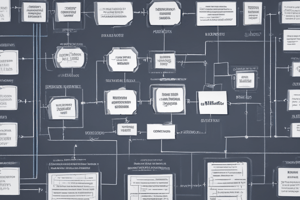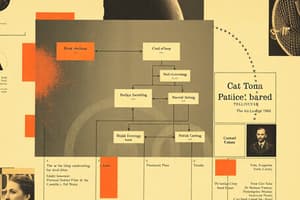Podcast
Questions and Answers
Which of the following is NOT a characteristic of a 'collaboration' within UML modeling?
Which of the following is NOT a characteristic of a 'collaboration' within UML modeling?
- Its internal representation includes the names of the collaborating entities.
- It represents a cooperative effort between multiple elements.
- It is defined solely by the sum of its individual parts. (correct)
- It is depicted graphically as an ellipse with a dashed line.
What differentiates an 'active class' from a standard class in UML?
What differentiates an 'active class' from a standard class in UML?
- Active classes have the ability to initiate actions. (correct)
- Active classes are used to model the behavior of software systems.
- Active classes are represented by a rectangle with a thick border.
- Active classes represent a physical component of the system.
Which of the following is NOT considered a structural entity in UML diagrams?
Which of the following is NOT considered a structural entity in UML diagrams?
- Actors (correct)
- Components
- Use Cases
- Node
Which of the following options correctly describes a 'Use Case' in UML?
Which of the following options correctly describes a 'Use Case' in UML?
What is the graphical representation of a 'component' in UML?
What is the graphical representation of a 'component' in UML?
Which statement best describes how a 'node' is represented in UML?
Which statement best describes how a 'node' is represented in UML?
Which of the following is NOT considered a type of 'behavior thing' in UML?
Which of the following is NOT considered a type of 'behavior thing' in UML?
What is the defining characteristic of 'behavior things' in UML?
What is the defining characteristic of 'behavior things' in UML?
Which of the following is NOT considered a type of 'structural entity' in UML?
Which of the following is NOT considered a type of 'structural entity' in UML?
Which of the following is NOT a core concept discussed in the text as relevant to the Unified Modeling Language (UML) for representing system behavior?
Which of the following is NOT a core concept discussed in the text as relevant to the Unified Modeling Language (UML) for representing system behavior?
Based on the provided text, which of these is a direct implication of the 'generalization-specialization' relationship in UML diagrams?
Based on the provided text, which of these is a direct implication of the 'generalization-specialization' relationship in UML diagrams?
If the "Perfectarea comenzii de achiziţionare a calculatorului" use case were to be further detailed, what would be the most appropriate approach based on the text?
If the "Perfectarea comenzii de achiziţionare a calculatorului" use case were to be further detailed, what would be the most appropriate approach based on the text?
The example provided about "calculatoare" (computers) in the context of the system illustrates the benefit of which UML concept?
The example provided about "calculatoare" (computers) in the context of the system illustrates the benefit of which UML concept?
Which statement best reflects the intention behind the process of building a UseCaseModel as described in the text?
Which statement best reflects the intention behind the process of building a UseCaseModel as described in the text?
What is the primary function of the Meta-Metamodel in the UML hierarchical structure of model representations?
What is the primary function of the Meta-Metamodel in the UML hierarchical structure of model representations?
What aspect of UML does the semantic aspect of the language focus on?
What aspect of UML does the semantic aspect of the language focus on?
Which of the following is NOT considered a component of the UML semantic model?
Which of the following is NOT considered a component of the UML semantic model?
When considering the various levels of UML model representations, which level directly deals with the user's specific objects and components?
When considering the various levels of UML model representations, which level directly deals with the user's specific objects and components?
What are the two categories of object models that are discussed in the text?
What are the two categories of object models that are discussed in the text?
What is used to describe the correspondence between the UML graphical notation and the semantic meaning of the concepts it represents?
What is used to describe the correspondence between the UML graphical notation and the semantic meaning of the concepts it represents?
The semiformality approach used to describe the semantics of UML involves the combination of which two aspects?
The semiformality approach used to describe the semantics of UML involves the combination of which two aspects?
What does the symbol '*' indicate in the context of client credits?
What does the symbol '*' indicate in the context of client credits?
How is the relationship of extension represented in use case diagrams?
How is the relationship of extension represented in use case diagrams?
What is a key feature of the extension relationship in use cases?
What is a key feature of the extension relationship in use cases?
What is indicated by the term 'exiles to extension points' in the context of the extension relationship?
What is indicated by the term 'exiles to extension points' in the context of the extension relationship?
What can be said about the basic use case in relation to its extensions?
What can be said about the basic use case in relation to its extensions?
What must occur for an extension to be allocated in a use case?
What must occur for an extension to be allocated in a use case?
Which statement accurately describes the relationship of extension?
Which statement accurately describes the relationship of extension?
What does the term 'consequence of actions' refer to in the context of use case behavior?
What does the term 'consequence of actions' refer to in the context of use case behavior?
In which way are the properties of a use case B affected by its extension from use case A?
In which way are the properties of a use case B affected by its extension from use case A?
What is implied if a use case has a direct extension relationship with another?
What is implied if a use case has a direct extension relationship with another?
What is the primary purpose of a use case in UML?
What is the primary purpose of a use case in UML?
Which component is typically used to represent a use case in UML?
Which component is typically used to represent a use case in UML?
What does a use case describe regarding the interaction between users and entities?
What does a use case describe regarding the interaction between users and entities?
How does a use case typically handle user requests?
How does a use case typically handle user requests?
What aspect of system behavior do use cases aim to capture?
What aspect of system behavior do use cases aim to capture?
What is a scenario in the context of a use case?
What is a scenario in the context of a use case?
What might a use case include in addition to regular service descriptions?
What might a use case include in addition to regular service descriptions?
In what context can use cases be beneficial?
In what context can use cases be beneficial?
What does the sequence of actions in a use case represent?
What does the sequence of actions in a use case represent?
Which of the following best describes the relationship between use cases and subsystems?
Which of the following best describes the relationship between use cases and subsystems?
Flashcards
UML Components
UML Components
UML consists of two interdependent parts: semantics and notation.
Semantics of UML
Semantics of UML
The semantics represent a metamodel defining the abstract syntax and semantics of object-oriented modeling.
Notation of UML
Notation of UML
The notation provides a graphical representation of the semantics in UML.
Static Models
Static Models
Signup and view all the flashcards
Dynamic Models
Dynamic Models
Signup and view all the flashcards
Four Levels of UML Representation
Four Levels of UML Representation
Signup and view all the flashcards
Meta-Metamodel
Meta-Metamodel
Signup and view all the flashcards
Use Case Diagram
Use Case Diagram
Signup and view all the flashcards
Actor in Use Case
Actor in Use Case
Signup and view all the flashcards
Generalization-Specialization Relationship
Generalization-Specialization Relationship
Signup and view all the flashcards
Use Case Model
Use Case Model
Signup and view all the flashcards
Class Diagram
Class Diagram
Signup and view all the flashcards
Collaboration
Collaboration
Signup and view all the flashcards
Use Case
Use Case
Signup and view all the flashcards
Active Class
Active Class
Signup and view all the flashcards
Component
Component
Signup and view all the flashcards
Node
Node
Signup and view all the flashcards
UML Structure Elements
UML Structure Elements
Signup and view all the flashcards
Behavior Entities
Behavior Entities
Signup and view all the flashcards
Actor
Actor
Signup and view all the flashcards
Signal
Signal
Signup and view all the flashcards
Elipse Notation
Elipse Notation
Signup and view all the flashcards
Service
Service
Signup and view all the flashcards
State Reset
State Reset
Signup and view all the flashcards
Annotations
Annotations
Signup and view all the flashcards
Exceptional Situations
Exceptional Situations
Signup and view all the flashcards
Behavior Specification
Behavior Specification
Signup and view all the flashcards
Use Case Package
Use Case Package
Signup and view all the flashcards
Multiplicity in Use Cases
Multiplicity in Use Cases
Signup and view all the flashcards
Extension Relationship
Extension Relationship
Signup and view all the flashcards
Graphical Representation of Extension
Graphical Representation of Extension
Signup and view all the flashcards
Base Use Case
Base Use Case
Signup and view all the flashcards
Conditions for Extension
Conditions for Extension
Signup and view all the flashcards
Extension Points
Extension Points
Signup and view all the flashcards
Adding Properties through Extension
Adding Properties through Extension
Signup and view all the flashcards
Independent Base Use Case
Independent Base Use Case
Signup and view all the flashcards
Execution Consistency
Execution Consistency
Signup and view all the flashcards
Use Case Behavior Control
Use Case Behavior Control
Signup and view all the flashcards
Study Notes
UML Contents
- UML (Unified Modeling Language) is a general-purpose modeling language
- Its used to specify, visualize, construct, and document business process and system components.
Development Stages
- UML development has evolved from various object-oriented modeling methods (Booch, OMT, OOSE)
- In October 1994, Booch and Rumbaugh started to unify their methods
- In 1995, the Unified Method (UML) 0.8 was released
- Jacobson joined in autumn 1995 to contribute OOSE
- The goal was to create a unified language and an easier modeling approach
Basic Components
- UML is composed of basic elements and their relations.
- Entities
- Structure: classes, interfaces, collaborations, use cases, active classes, components, and nodes
- Behavior: interactions and state machines
- Grouping: packages
- Annotations: notes
- Relations
- Dependency
- Association
- Aggregation
- Composition
- Generalization
- Realization
Use Case Diagrams
- Use case diagrams visualize actor interactions with a system.
- Actors: external entities interacting with the system
- Use cases: actions the system performs for the actors
- They show the system's functionality from the users' perspective.
- Use cases and actors are linked with associations.
Class Diagrams
- Class diagrams represent the system's static structure, showing classes and their attributes.
- Attributes: properties of classes
- Operations: actions performed by classes
- Relationships: associations, inheritance (generalization), and realization
- Classes are grouped into packages for better organization.
Object Diagrams
- Object diagrams illustrate instances of classes.
- Instances are specific objects that conform to particular class descriptions, hence they are not represented without a class.
- They show the object's attributes and their values at a given moment.
Statechart Diagrams
- These diagrams depict the lifecycle of an object instance, showing its different states and transitions.
- States
- Representing the different conditions or stages an object can be in.
- Transitions
- How an object moves from one state to another following certain events, triggers, guards etc.
- They are useful for modeling dynamic behavior.
Activity Diagrams
- Activity diagrams visually track the flow of execution within a system or part of system.
- Activities: tasks or actions
- Transitions: flow from one activity to another
- Control-flow constructs (e.g., decisions, loops)
- They can represent concurrent activities and conditional operations.
- Swimlanes: used to arrange activities by the different responsibilities involved in the task.
Interaction Diagrams
- These diagrams are used to show the different types of interactions between objects. They can be
- Sequence diagrams
- Collaboration diagrams
- Both are types of Interaction Diagrams.
Sequence Diagrams
- Sequence diagrams illustrate message exchanges between objects over time.
- Object lifelines: depicted as vertical lines.
- Messages: depicted as arrows connecting lifelines, representing communication points over time.
- The order of messages on the diagram reflects the sequence of execution.
Collaboration Diagrams
- Collaboration diagrams show interactions between objects, but the focus is on the structural links between them rather than on the sequence of occurrence over time.
Component Diagrams
- Component diagrams display the physical structure of a software system, showing the components and their dependencies.
- It shows the physical structure and configuration of a software system.
Deployment Diagrams
- Deployment diagrams represent the physical deployment of software components on hardware nodes.
- Nodes: physical computing resources like servers, laptops or various devices.
- Components: software elements deployed onto nodes
- Links: communication paths or connections between nodes.
- These diagrams show the system's physical architecture.
Studying That Suits You
Use AI to generate personalized quizzes and flashcards to suit your learning preferences.




